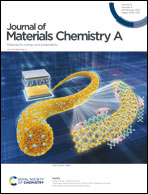Quantifying the energy loss for a perovskite solar cell passivated with acetamidine halide†
Abstract
Defects at the grain boundary, surface and interface, acting as nonradiative recombination centers, result in considerable energy loss of perovskite solar cells (PSCs). Herein, we passivated the defects of polycrystalline perovskite films with acetamidine halide (AAI or AABr) and identified their energy loss before and after passivation. We find that the trap state densities are 9.20 × 1015 cm−3 and 9.62 × 1015 cm−3 for AAI-treated and AABr-treated perovskite films, lower than 1.09 × 1016 cm−3 for the pristine film. As a result, PSCs with configuration of ITO/SnO2/perovskite/spiro-OMeTAD/Ag achieve a champion PCE of 22.0% with AAI treatment and 21.5% with AABr treatment, higher than 20.4% PCE for the pristine PSCs. In LED mode, the maximum electroluminescence external quantum efficiencies (EQEEL) are 4.06% and 3.45% for AAI and AABr passivated PSCs, respectively, higher than 0.94% for the pristine device. EQEEL values are 1.26%, 1.20% and 0.40% under an injection current of photocurrent for AAI, AABr and pristine PSCs suggesting that the nonradiative VOC loss is 112 mV, 114 mV and 142 mV, respectively. In terms of charge transfer loss, fill factor reduction is estimated to be 6.3%, 7.0% and 7.4% for AAI, AABr and pristine films, respectively. Passivation using acetamidine halide can significantly improve the energy loss and improve stability.



 Please wait while we load your content...
Please wait while we load your content...